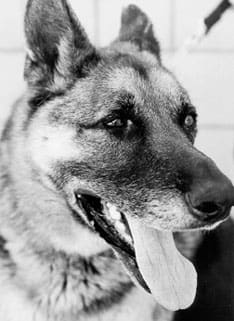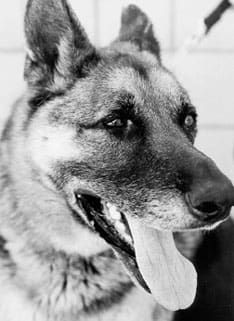Recently I witnessed an intriguing “conversation” that took place on an Internet bulletin board between two owners of older dogs. One of the individuals inadvertently started a small fracas when she characterized her seven-year-old Great Dane as old.
“What are you talking about?” demanded another party to the discussion. “I have an 11-years-young Dane who is just as active and healthy as ever. How is your dog bred? If your dog looks old at seven, I’d like to avoid that particular line of dogs!”

To serious dog breeders, a denigrating comment about a dog’s breeding is “fighting words!” But the owner of the seven-year-old dog calmly resisted the bait, and made a wise and notable point in her reply:
“My dog is just as active and healthy as ever, too,” she wrote. “But I’m not ‘in denial’ about his age. By recognizing that his needs are changing as he gets older, I can tailor his diet, exercise, and care to maximize his longevity.”
Granted, a breeder who has produced a Dane that lives to be 11, without exhibiting overt signs of old age, is to be commended. However, of the two people in the discussion I observed, the owner of the seven-year-old is the sagacious one. She has realized that if you are alert to the signs of aging in your dog – to a certain extent – they can be headed off at the pass. In fact, failing to “see” signs of aging puts a dog at a higher risk of succumbing to a whole range of age-related illnesses.
Common conditions
The onset of “old age” in dogs varies by breed and size, but generally, the larger the dog, the fewer years it takes for him or her to appear geriatric. This is the average scenario, however; disease, stress, inadequate nutrition, and indifferent care can cause premature aging, as well as hasten the end of the dog’s life.
Fortunately for us canine caretakers, the conditions that plague older dogs are fairly easy to observe – if you know what you are looking for. Most are also easy to treat, as long as you are willing to make some changes in your dog-care plan.
Over the next few months, WDJ will discuss some of the most common health problems of the older dog, along with some common-sense treatments for them. This month, we’ll look at one of the classic diseases of aging dogs: osteoarthritis or degenerative joint disease.
Common but cruel
Osteoarthritis is a degenerative joint disease in which the cartilage that covers the ends of bones in the joint deteriorates, causing pain and loss of movement as bone begins to rub against bone. The chronic inflammation causes deterioration of the joint and the pain and limited movement.
A dog with osteoarthritis is typically stiff in the morning and after naps. He will usually “warm” out of it as he gets up and walks around a little, though cold, damp weather can temporarily cripple him with pain.
These are classic symptoms of a fairly common disease, however, a veterinarian’s opinion should be sought before you begin any course of home treatments for the condition. Dogs with other reversible diseases can also exhibit these symptoms, and if you automatically treated the dog for arthritis when he, in fact, had something else, you’d have wasted the best (i.e. the earliest) opportunity to treat his real illness.
Treatments
One of the first considerations is reducing the dog’s pain. A dog that is too sore to exercise often gains weight (which aggravates the arthritis) and becomes depressed (which makes him more reluctant to exercise). These dogs need to exercise to both prevent excessive weight gain and to maintain muscle strength.
Buffered aspirin is often given to dogs with osteoarthritis. Aspirin is considered the most effective and safest drug for relieving some of the dog’s pain. Like all drugs, it’s not without potential for side effects. Some dogs who have been given aspirin for long periods of time or in high doses may develop gastrointestinal bleeding or ulcers. Using buffered aspirin can help prevent this.
Most other herbal and nutritional treatments for this disease are focused on reducing the inflammation that causes pain.
For humans with osteoarthritis, the new generations of non-steroidal anti-inflammatory drugs (NSAIDs) have been highly effective in reducing inflammation, and thus, reducing pain. However, they have not been shown to be as effective in dogs; aspirin is still the veterinarian’s treatment of choice.
“Neutraceuticals”
In recent years, glucosamine sulfate and chondroitin sulfate have emerged as the most highly touted arthritis “cures.” Some human arthritis patients swear by these supplements; some report no benefits at all.
Countless medical breakthroughs have emerged from the following model: As medical researchers learn about the role of any chemical component of the healthy and diseased human body, their first step is often to replicate any substance that they discover to play a role in a disease process. Then they supplement a diseased person with the substance, to see whether added amounts of the substance will slow or stop the disease. That’s how these substances made their way to the marketplace.
Glucosamine is naturally produced by the body, and plays an important role in the repair and maintenance of articular cartilage. Manufactured glucosamine sulfate and chondroitin sulfate are artificially synthesized salts of glucosamine. In the short term, these substances seem to stimulate the cartilage cells to rebuild themselves, rather than degrade as a result of the osteoarthritis process. Long-term studies have not demonstrated the substances’ ability to control the osteoarthritis disease process.
Cosequin is the best-known supplement for dogs that contains both glucosamine sulfate and chondroitin sulfate; it also contains vitamin C and manganese, and is available only through veterinarians. (For more information, call Nutramax Laboratories, 800-925-5187.) There are also a plethora of other manufacturers of the substances; any health food store’s shelves will be full of these products. One advantage of Cosequin is not having to guess at dosages.
Adequan (polysulfated glycoseaminoglycan) is another commercial form of glucosamine, but is injected rather than fed. It is theorized that this artificial cartilage matrix substance deposits in the various joints of the body and replacing the cartilage in the arthritic joint and thickening the fluid surrounding the joint. Adequan has been approved by the FDA for use in horses, but is still unapproved for use in dogs; nevertheless, it’s used on dogs daily. The maker (Luitpold Pharmaceuticals, 800-458-0163) expects to have FDA approval soon.
Nutritional supplements
In recent years, a number of nutritional supplements have been used to treat arthritis with some success. Perhaps the most exciting is vitamin C. We’ve seen great results from vitamin C supplements of 500 to 2,000 mg. per day, depending on the dog’s size.
Vitamin C is often combined with other nutrients in “arthritis” formulas. One such mix is “ACA,” which contains pure ground alfalfa leaf – another traditional herbal remedy for arthritis), vitamin C, selenium, vitamin E, and chromium (available from The Natural Pet Care Catalog, 800-962-8266).
Another supplement formulated specifically for arthritic conditions is “Winston’s Joint Formula,” made by Winston’s Best (310-277-6120). This contains vitamin C along with a plethora of other nutrients, including shark cartilage (thought to help rebuild the dog’s cartilage), and bromelain (taken from pineapple enzyme and meant to replicate a collagen structural protein).
Fresh or dried alfalfa can also be used to promote healthier joints. Willow is a natural pain reliever, and taken as an infused tea internally mixed with alfalfa and burdock, provides pain relief. Fresh garlic seems to help many canine arthritis patients; chop 1/2 to three cloves (depending on the dog’s size) into his food.
Dog keeping strategies
There are a number of things you can around the house to make your arthritic dog more comfortable. For instance, using a raised feeding stand can keep a dog from having to bend down to eat. Dogs that are having trouble negotiating stairs would probably appreciate ramps where it is possible and feasible to build one. If the dog lives outside, providing an exceptionally warm place for him to sleep, well off the ground, will help him from waking up sore every day.
Giving the dog the thickest, softest bedding available will help also him as much as it would a human. Ideally, use a bed with thick “egg crate” foam, which will help distribute his weight evenly on the bed and reduce pressure on any individual joints. The thickest foam dog bed we’ve seen is the “Super Deluxe Bed’ from the Drs. Foster & Smith catalog (800-826-7206).
Another item which seems to have a growing number of proponents is the Nikken Magnetic Pet Pad (Kenko PetPad). Theoretically, magnets ease arthritis pain by properly “polarizing” the dog’s own magnetic field. Nikken is a multi-level marketing company (see “Multi-Level Marketing Mysteries, May 1998, WDJ), but we know two representatives who promise not to try to sell you anything other than what you express interest in: Mary Ann Land, 612-494-9732, and Edith Montoya, 888-841-6073.
Finally, touch therapies can soothe the achy muscles the dog may suffer from altering his gait and movement in an effort to escape the aches from his joints. (See “A Touch Should Do It,” July 1998 WDJ for TTouch, massage, and acupressure resources.) Acupuncture, too, has been shown to be helpful in relieving the pain and stress of arthritis. For a local acupuncturist, call the International Veterinary Acupuncture Society at 303-258-3767.







This is overall great advice, and I love to support The Whole Dog Journal. I’m disappointed to see that physical rehabilitation has been left out of this article. Rehab can greatly increase the quality of life of dogs with even severe OA and help reduce the amount of medication they take. I would be happy to provide more information, or even a case study I have written up on a wonderful cattle dog who had a severe lameness resolve with rehab. If you would like to do a piece on physical therapists in rehab or just rehab itself, please do contact me. I’ve been in the field for 10 years, a PT for 16. It would be wonderful to let more people know there is so much more they can do with their pets.